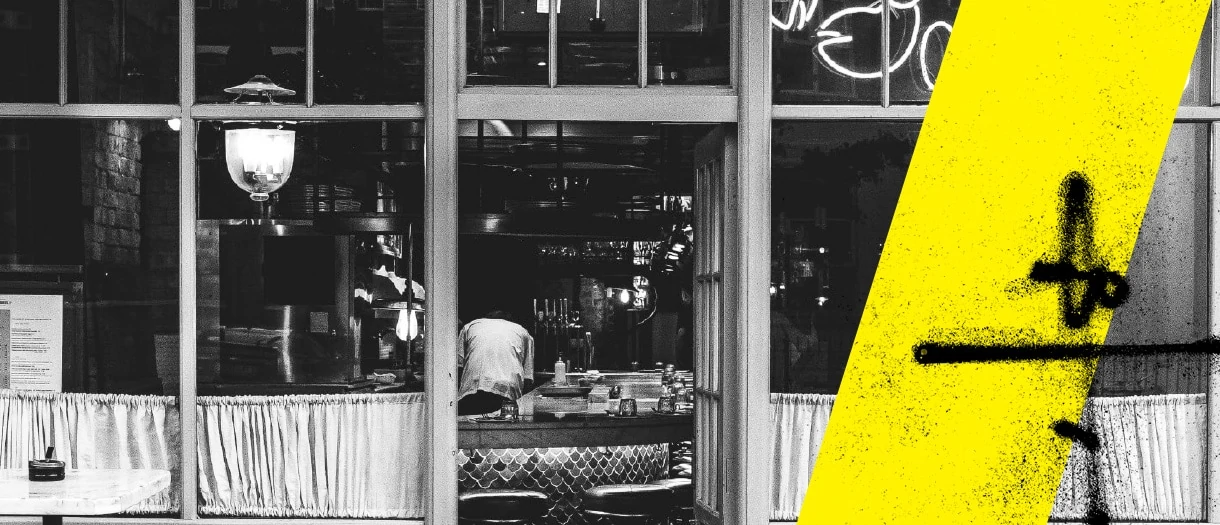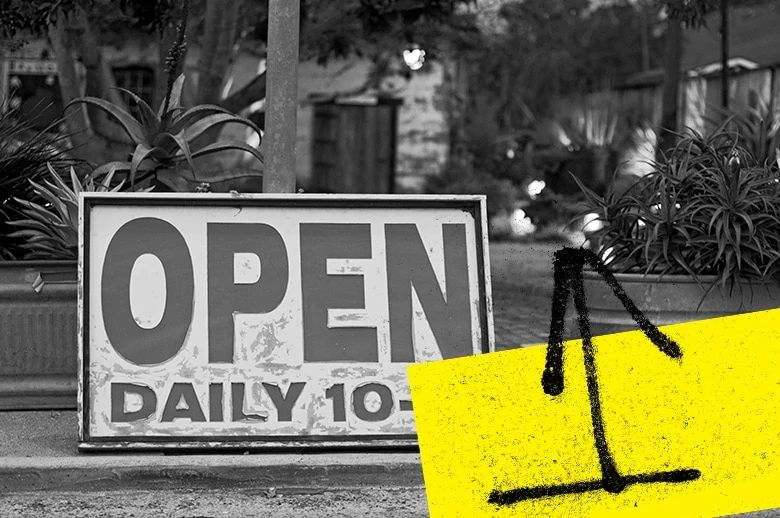If you build it, will they still come?

Summary
For bricks-and-mortar businesses, few interruptions can be as costly as construction on your street. We explore how two Canadian public infrastructure projects led to declines of between 30% and 50% of
business on major commercial thoroughfares. With a good marketing strategy, cooperative spirit and a bit of creativity, though, construction season can be more manageable. We offer tips on how to encourage the foot traffic to keep coming.
Street construction can hamper pedestrian traffic to small businesses. Here are a few tips to survive the downturn.
They say there are two seasons in Canada: winter and construction season.
From sidewalk repairs to massive transit infrastructure builds, no city is free from the sound of jackhammers and the sight of orange hard hats.
While, to passersby, these activities are usually little more than a touch of noise pollution and a few inconvenient detours, for the small business owners whose storefronts and restaurants are subject to ongoing commotion, they could be signs that tough times are coming.
With considerable infrastructure investment from the federal government underwriting big new projects in Canada’s major cities—light rail in Toronto, Hamilton and Ottawa, a convention centre in Halifax, road repairs in Montréal—these disruptive but ultimately necessary renewal efforts are set to make construction seasons last longer.
Small businesses with tight margins bear the biggest brunt, with pedestrian traffic dropping off and commuting customers opting to bypass these areas altogether. Consider the Crosstown LRT project in midtown Toronto: the 10-kilometre underground light rail project is believed to be the cause of a 50% downturn in business for the shops and restaurants along Eglinton Avenue in some stretches.
In Ottawa, a long-gestating light rail project through the capital’s downtown core left proprietors on the city’s Queen Street wondering if they could survive construction. Seemingly never-ending road-repair efforts on St-Denis Street and in Notre Dame de Grâce in Montréal led to numerous business closures throughout 2016. Businesses on King Street in Kitchener estimated that they saw a 30% reduction in business during LRT construction in 2015 —and Hamilton is getting ready for a similar project to start really disrupting traffic in 2020.
So what’s a small business to do?
In a word, marketing. (This is a journal on branding and marketing, after all).
Tapping into a big marketing budget is a non-starter, but there are a handful of low-cost tactics that might make the difference in living to fight another day.
Talk to the city.
Increasingly, city governments and affected businesses are working together before shovels hit the ground to offset potential losses. Construction mitigation plans, when they exist, can offer low-interest loans, marketing support, cash or other services to help small businesses survive, but Canadian cities tend to lag behind American ones in adopting them.
For example, planners at the City of Toronto have recommended that the city implement mitigation plans ahead of major construction projects in the wake of the Crosstown LRT, but the city remains non-committal. Metrolinx, the provincial body behind the Crosstown construction, has also offered business improvement areas (BIAs) up to $10,000 each in marketing support, as well as free window washing services to keep storefronts looking their best.
In Montréal, Mayor Valérie Plante announced in June 2018 that the city was setting aside a $25 million fund for businesses affected by construction, retroactive to 2016. Businesses were limited to a total of $30,000, though, and it’s unclear whether businesses that shut down were entitled to a
share of the fund.
If your city does fund a construction mitigation plan, then it still will likely fall to you to reach out to your BIA or civic representative to see how you can access that money and what limits will be placed on it. But every nickel helps—and more cities might soon be following Montréal’s lead. In Halifax, the much-delayed construction of a new convention centre in the city’s downtown led to seven businesses joining together to sue the city, the province and others. The businesses eventually dropped the case in 2017 due to mounting expenses, but its viability in court hasn’t been tested—and other cities might not want to find out what that result might be for themselves.

Get to know your new neighbours.
While some existing customers might be put off by the construction, there’s a new market waiting to be tapped: the construction crews, police officers and other attendant workers right outside your door.
During a revitalization project in Bangor, Maine, affected bars and restaurants in the small city reached out to the construction workers through a “Hard Hat Happy Hour” promotion. Construction workers were entitled to discounted beverages at a different bar each week, and the bars held raffles for gift certificates to nearby businesses to encourage more foot traffic during construction—and hopefully land a few returning customers once the work was done.
Naturally, this tactic is better suited to bars, cafes and restaurants than to retail operations, but a couple of creative adjustments can help you entice sales from this relatively captive market. First, get them through the door with the promise of free coffee or ice water. Then follow up with a targeted discount or offer that aligns to this new market: a florist might not have too much that immediately speaks to a crew of typical construction workers, but each of those workers probably has a mother or a partner who wouldn’t mind a new, discounted floral arrangement!

Let people know you’re open for business.
If you’re suffering through construction woes, then it’s likely your fellow nearby businesses are, too.
But pain doesn’t have to be the only thing shared with your neighbours. While an “open for business” ad in the local paper or on the radio may be too much for one business to afford, that same cost split among 10 businesses is far more easily handled.
Ditto for efforts in the digital space. If your BIA or neighbourhood has a Facebook page or group, you and your fellow businesses can post for free, letting your community know that you’re open. If there’s no neighbourhood presence on Facebook, make a group yourself, and post regular updates about local businesses or construction progress to attract eyeballs—and eventually wallets. Better yet, tie in a promotion for anyone who mentions your Facebook presence when they drop by your business.
Retailers and restaurants might want to take a cue from Minneapolis, where a light rail project served as their impetus for getting online. The 11-mile Green Line project broke ground in 2010—and affected around 800 small businesses. With the help of a public–private partnership established by non-profits and government agencies, bricks-and-mortar retailers built websites where they could continue sales online, while restaurants overhauled their websites to expand their catering footprint. Other businesses took some of their downtime to prepare email databases of their most valued customers so that they could reach out to them during fallow periods.
Of course, not every tactic you take has to be so in-depth: urban planning expert Andy Yan of Simon Fraser University’s City Program recommends the tried, tested and true tactic of simply putting up a highly visible sign. Letting passersby know that your block of shops is open can be just as impactful, especially for the pedestrians who live in your neighbourhood and are most likely to continue patronizing you after construction has finished.
Protest—but protest creatively.
When all else has failed, hit the streets. The great thing about a loud and proud protest is that it’s sure to attract media interest. The drawback is that, once it’s in the hands of the media, a protest can be framed in all sorts of ways that you don’t have any control over.
Consider the case of Toronto’s King Street Pilot Project. Launched in late November 2017, the King Street Pilot Project aimed to cut down commute times for the roughly 64,000 people who took the King streetcar—Toronto’s busiest surface route—each day to and from work. While commute times did decrease overnight, a handful of small businesses on the street claimed that the limited car presence was turning customers away. (A city report announced a slight increase, in fact, of year-over-year spending in the area.)
The owner of the Kit Kat Italian Bar & Grill, Al Carbone, decided to share his frustrations by installing a large ice sculpture of a middle finger outside his front doors, clearly visible to all who passed by in the streetcar. A few other restaurants along King followed suit.
While the sculptures certainly drew interest from Torontonians, a healthy share of that was ire, with many transit-takers assuming the fingers were pointed at them—not a great development for the restaurant’s brand. Carbone later clarified that the middle finger was meant to be directed to the TTC and the municipal government, but when you have to clarify who is on the receiving end of your large middle finger, the protest has already got away from you.
After a few weeks of the ice sculptures (and, presumably, not much in the way of new sales), Carbone and Co. launched a different protest against the streetcar project: street hockey games in the middle of King Street West. The lunch-hour protest drew many spectators in person—including cameras from the news media—as well a more inviting, celebratory air.
Video of players shouting “streetcar!” every time they had to move their nets resonated with anyone who grew up shouting “car!” on their own childhood streets. Best of all, there was Kit Kat in the background of every shot, earning free—and overwhelmingly positive—coverage in the doldrums of winter.
In 2019, Toronto City Council voted to make the pilot project permanent, after daily ridership increased by some 20,000. And while Carbone continued to express his displeasure, there were no more icy middle fingers to be found this time around.
Of course, being “creative” is much easier said than done, especially with limited resources. At the very least, think visual—what would look good on television or in a photograph—and try not to alienate customers, potential or existing.